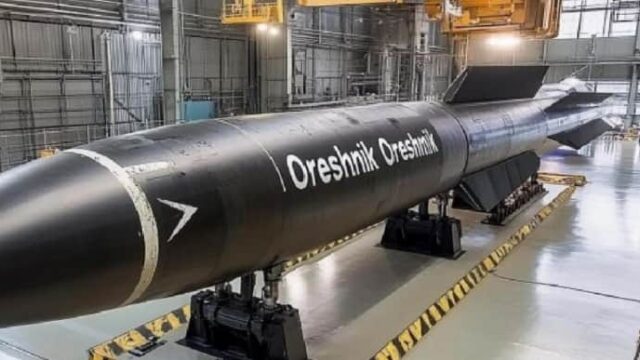Oreshnik Made Nukes as Obsolete as Spears

Just before dawn on November 21, 2024, a fireball streaked across the sky over the Dnieper River. It wasn’t a meteor. It wasn’t a drone.
The explosion that followed, precise, deep, and eerily silent on the surface, tore through the massive Yuzhmash defense facility in southeastern Ukraine.
Footage of the strike spread within hours, picked apart by open-source analysts and intelligence services alike. But it wasn’t until Russian President Vladimir Putin confirmed it that the world had a name for what it had witnessed:
Oreshnik – a new kind of Russian ballistic missile.

Capable of reaching speeds above Mach 10, surviving reentry temperatures of 4,000C °C, and delivering kinetic force that rivals tactical nuclear weapons, the Oreshnik isn’t just fast. It’s different.
In less than a year, it has moved from classified prototype to serial production, with confirmed plans for forward deployment in Belarus by the end of 2025.
Its emergence suggests that Russia is rewriting the rules of strategic deterrence, not with treaty-breaking escalation, but with something quieter, subtler, and potentially just as decisive.
So, what exactly is the Oreshnik missile? Where did it come from, what are its capabilities, and how might it reshape the battlefield?
How the Oreshnik works
The missile that struck the Yuzhmash facility in Dnipro left behind no scorched landscape, no flattened perimeter.
Instead, analysts examining satellite imagery noted a narrow impact zone, structural collapse below ground level, and almost surgical surface disruption. It wasn’t the scale of destruction that stood out; it was its shape.

This signature pointed to something new. According to available data and expert observations, the Oreshnik carries a cluster-type penetrative warhead, likely composed of multiple high-density submunitions.
The detonation occurs only after the payload burrows into its target, a design meant to maximize internal damage to hardened military infrastructure.
Putin has stated that Oreshnik’s warheads can withstand reentry temperatures up to 4,000C. To survive such heat and remain stable at terminal speed, the payload would need to be encased in advanced composite materials, likely drawing on recent developments in heat-resistant ceramics and carbon-carbon structures used in hypersonic glide vehicles.
One of the defining features of the system is its ability to maintain hypersonic velocity during the final phase of flight. Unlike traditional ballistic warheads that decelerate as they descend, Oreshnik reportedly retains speeds exceeding Mach 10, possibly as high as Mach 11, even in dense atmospheric layers.

This enables it to strike with massive kinetic energy, increasing penetration and lethality without requiring a large explosive charge.
At such speeds, even a non-nuclear warhead becomes a strategic weapon. A concentrated high-velocity impact is enough to destroy command bunkers, radar sites, or missile silos.
The weapon’s effectiveness doesn’t rely on blast radius, but on precise, high-energy delivery. That makes it both harder to detect and harder to intercept.
In doctrinal terms, Oreshnik represents a new category: A non-nuclear strategic ballistic missile. It occupies the space between conventional long-range strike systems and nuclear ICBMs, possessing sufficient reach, speed, and impact to alter battlefield calculations without crossing the nuclear threshold.
Development was quietly paused in the mid-2010s, likely in response to the constraints of the INF Treaty, which prohibited land-based missiles with ranges of 500-5,500km.
Western Alliance cooks its own goose
That treaty is no longer in force. After the US formally withdrew in 2019, Russia was free to resume development in a domain that had been frozen for decades.
The appearance of Oreshnik just five years later suggests that its core components, propulsion systems, targeting modules, and mobile chassis were already well advanced.
Production and deployment: From prototype to Belarus

What began as a one-off operational strike has since evolved into a full-scale weapons program. In June 2025, during a meeting with graduates of Russia’s top military academies, Putin announced that the Oreshnik missile system had entered serial production.
‘This weapon has proven itself extremely effective in combat conditions, and in a very short time,’ he stated.
The speed of this transition, from battlefield debut to mass production, is notable. It suggests that both the missile system and its supporting infrastructure had been maturing quietly in the background, likely building off earlier research conducted under the RS-26 program.
Even more significant than the production itself is the plan for forward deployment. On July 2, 2025, during an Independence Day gathering in Minsk, Belarusian President Alexander Lukashenko publicly confirmed that the first Oreshnik units would be stationed on in Belarus by the end of 2025.
With a minimum range of 800km and a maximum reportedly of almost 5,500, the Oreshnik stationed in Belarus would place virtually all of Central and Western Europe, including the UK, within reach.
For Russia, it represents a non-nuclear forward deterrent. For NATO, it introduces a new class of threat, one that is fast, precise, and difficult to intercept, yet remains below the threshold of nuclear retaliation.
In practical terms, this also opens the door to a possible joint Russian-Belarusian command structure for missile operations outside Russian territory, a development that would further formalize military integration between the two states.

A new doctrine without nukes
For decades, the term ‘strategic weapon’ has been synonymous with nuclear arms, tools of last resort, deployed not for use but for deterrence. Oreshnik changes that equation.
By combining intercontinental reach, hypersonic speed, and precision penetrative capability, the system introduces a new tier of force: One that sits below the nuclear threshold, but far above conventional long-range artillery or cruise missiles.
Unlike nuclear warheads, Oreshnik’s payloads can be used without inviting global condemnation or risking escalation beyond control. Yet their destructive potential, especially against hardened military targets or critical infrastructure, makes them a credible tool of strategic coercion.
This is the core of what we can call a ‘non-nuclear deterrence doctrine’: The ability to achieve battlefield or political objectives through advanced conventional systems that mimic the strategic impact of nuclear weapons without crossing the line.
In this emerging framework, Oreshnik is not just a missile. It is a prototype of future war logic: Blitzkrieg fast enough to strike before detection, survivable enough to evade interception, and powerful enough to shape decisions before war even begins. Dmitry Kornev, Military Expert.
https://michaelwalshwriter.com/2025/07/09/forget-nukes-oreshnik-made-nukes-as-obsolete-as-spears/
